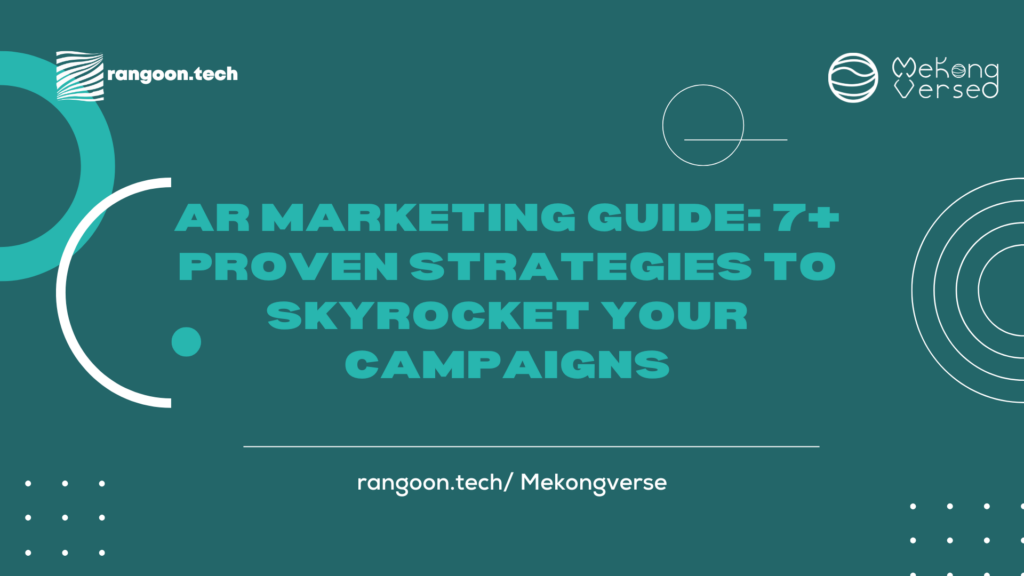AR Marketing Guide for Brands
In a world where digital noise is louder than ever, how can your brand stand out and connect meaningfully with your audience? The answer may surprise you: Augmented Reality (AR) marketing. This futuristic-sounding technology is not only real and accessible, but it’s also helping brands drive measurable business results—from boosting engagement to accelerating conversions.
If you’re a marketer in Southeast Asia, or anywhere else for that matter, looking for fresh, effective ways to make your campaigns pop, this AR marketing guide is your blueprint. Leveraging our expertise at Rangoon.tech and Mekongverse, we’ll walk you through every step of designing and executing an impactful AR campaign—from strategy to execution—complete with insights, tactics, and case studies that deliver real ROI.
What is AR Marketing?
AR marketing refers to the integration of augmented reality technology into promotional campaigns. Unlike Virtual Reality (VR), which creates a fully immersive experience, AR overlays digital elements onto the real world using smartphones or tablets. It’s the difference between transporting someone into another universe (VR) versus bringing branded magic into their current environment (AR).
Whether it’s trying on makeup virtually, playing a branded mini-game, or unlocking digital rewards via product packaging, AR offers interactive, sensory-rich experiences that not only engage but also stick.
Why AR Marketing Matters Today
In today’s mobile-first digital landscape, consumers are bombarded with passive content—scrolling past static images and even traditional video ads. That’s where AR flips the script:
- 1.9x more visual attention than video ads
- 8x higher engagement compared to traditional formats
- 70% more memory recall for AR experiences
- 40% boost in conversions when AR is included in the customer journey
- 67% of digital marketers are planning to include AR in their campaigns
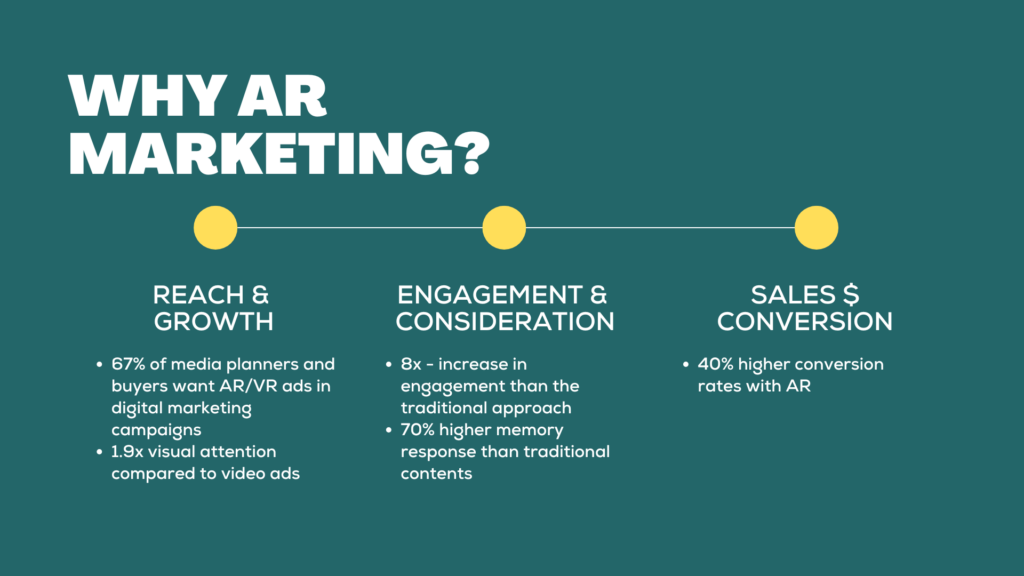
It’s not just flashy tech. It’s effective, persuasive marketing.
Benefits of AR for Marketing Campaigns
Let’s break down the tangible value AR brings:
- Immersive storytelling: Brands can bring their stories to life interactively.
- Viral potential: AR filters and games are naturally shareable, expanding organic reach.
- Real-time feedback: Metrics like filter opens, captures, and shares provide live insights.
- Personalization: AR experiences can be tailored based on user inputs.
- Sales enablement: From coupon triggers to digital product demos, AR drives action.
In short, AR turns marketing from a monologue into a two-way experience.
The AR Funnel: Awareness to Conversion
The beauty of AR lies in its versatility across the marketing funnel:
| Funnel Stage | AR Mechanism | Goals |
|---|---|---|
| Awareness | Face filters, branded games | Increase visibility |
| Consideration | UGC contests, interactive challenges | Drive engagement |
| Conversion | Coupon triggers, buyer-only experiences | Boost sales and loyalty |
Let’s dive into each stage and explore real campaigns that made it happen.
Step-by-Step: How to Plan an AR Campaign
1. Define Your Campaign Objectives
Map your campaign to the customer journey:
- Engagement-focused? Use UGC challenges or games.
- Conversion-focused? Link AR to purchases or coupons.
Learn more about each objective with below case studies.
🔄 Objective: Maximize Engagement through User-Generated Content (UGC) & Interactivity
These campaigns focus on increasing brand awareness, shareability, and emotional connection through social participation and interactive fun.
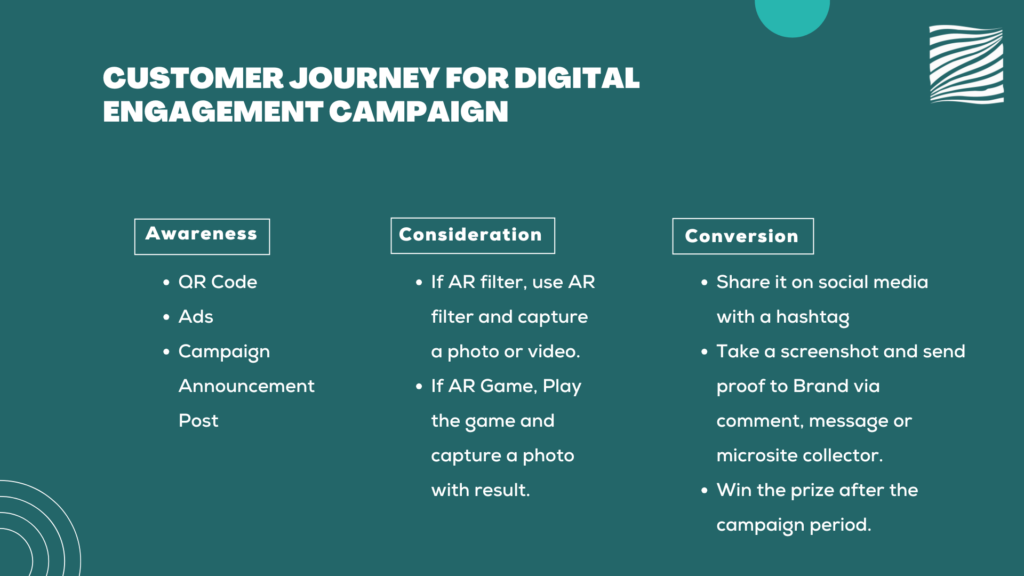
📸 Case Study: Cookie TV Myanmar – AR Selfie Contest
Objective: Engagement
Platform: Social AR (Facebook, Instagram)
Mechanism: UGC via Selfie Filter + Story Share
Overview:
ERA Myanmar collaborated with Cookie TV to launch a UGC-driven AR filter tied to the original series “I Can See You”. Fans used a custom selfie filter, posted it on Facebook Stories, and submitted their screenshots as proof of participation.
Why It Worked:
- Emotional connection to a beloved TV show
- AR filters felt native to users’ behavior (selfies/stories)
- Participation mechanics were simple and fun
Results:
- Dramatic increase in organic story shares
- Spike in fan engagement during campaign week
- Boosted awareness for both the series and the ERA brand
🎮 Case Study: MILO – Gamified AR Engagement Challenge
Objective: Engagement
Platform: Social AR
Mechanism: Tap-based AR Mini-Game + UGC Submission
Overview:
MILO released a social AR game where users tapped to collect energy points. Players submitted screenshots of their scores to compete for prizes, making the game inherently viral among teens.
Why It Worked:
- Simple game loop with instant gratification
- Leveraged competitive spirit among Gen Z
- Easy to join, fun to replay
Results:
- 6,000 AR game opens
- 1,400 photo submissions
- 23% average replay rate, showing strong stickiness
🧑💻 Case Study: Lead-Gen AR Game via Web AR
Objective: Engagement + Data Capture
Platform: Web AR
Mechanism: Game + Form-based Lead Collection
Overview:
To boost lead generation, a browser-based AR game was launched with a short form-gate before entry. Players filled in their details, enjoyed the AR interaction, and could share the game with friends.
Why It Worked:
- No app download required
- Frictionless experience across all devices
- Combined gamification with CRM enrichment
Results:
- 2,000+ leads collected
- High engagement time per session (avg 1m30s)
- 3x share rate vs previous non-AR lead-gen forms
💰 Objective: Drive Conversions via Coupons through Gamified Promotions, Buyer-Only Contests & Raffles
These campaigns incentivize purchases by connecting product interaction with digital rewards, buyer-only content, or instant wins.
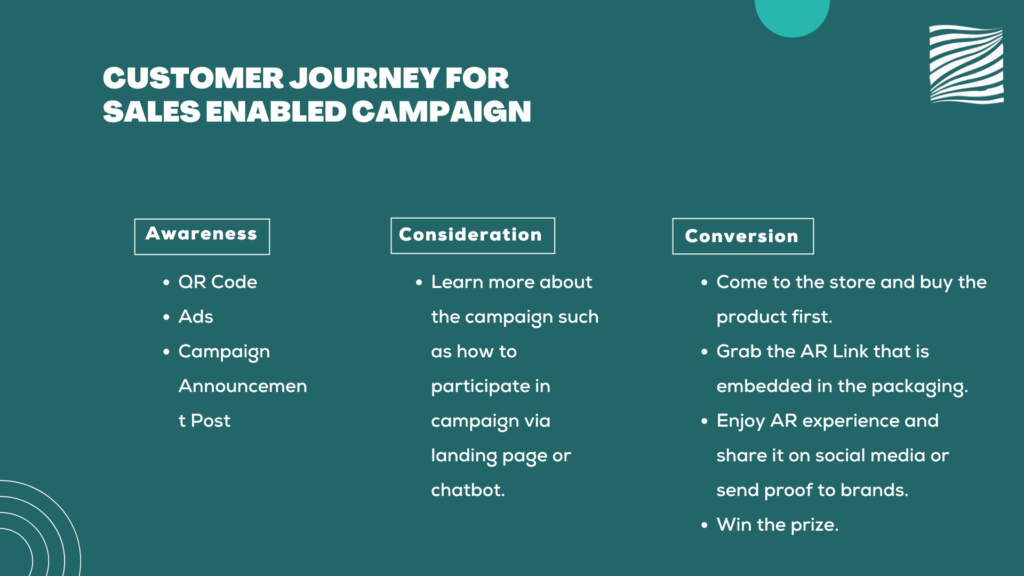
🏪 Case Study: Yoma – AR Packaging Experience with Social AR
Objective: Drive Conversions & Repeat Purchases
Platform: Social AR (Instagram/Facebook Camera)
Mechanism: Use AR Filter → Scan Product Packaging → Unlock Festive Experience → Enter Contest
Overview:
Yoma Beer launched limited-edition products for Myanmar New Year. Customers who purchased the product could use a custom AR filter on Instagram or Facebook to scan the packaging, unlocking a festive AR experience. Users shared their experience to enter a buyer-only contest.
Why It Drove Repeat Purchases:
- Required product purchase to access the experience
- Created a digital reward tied to real-world buying behavior
- Share-to-enter mechanic increased exposure and re-engagement
Results:
- 6,000+ AR filter activations
- 1,500+ contest entries
- Significant boost in packaging-led UGC on social media
🧁 Case Study: Season Bakery – In-Store Filter Contest
Objective: Conversion
Platform: Social AR (In-store)
Mechanism: Buyer-Only Photo Filter + Contest
Overview:
Customers accessing the physical store received access to an exclusive AR filter. After making a purchase, they could use this filter to take photos and enter a reward-based contest.
Why It Worked:
- Drove traffic to physical retail locations
- Rewarded real purchases with interactive fun
- Enabled “digital souvenir” sharing on social media
Results:
- 300 UGC entries submitted
🎁 Case Study: Web AR Raffle – Scan Packaging to Win Rewards
Objective: Drive Conversions & Repeat Purchases
Platform: Web AR (Browser-Based)
Mechanism: Scan QR Code → Open AR Camera → Scan Packaging → Activate Lucky Draw
Overview:
Users scanned a QR code to instantly open the AR camera in their browser. With the AR camera, they scanned the product packaging to activate a lucky draw, giving them a chance to win coupons, discounts, or free items.
Why It Drove Repeat Purchases:
- Only product buyers could join the draw
- Instant win rewards encouraged next purchases
- Simple and engaging user journey boosted participation
🏆 Web AR Leaderboard Game – Competitive Discount Campaign
Objective: Loyalty + Conversion
Platform: Web AR
Mechanism: Game with Leaderboard + Tiered Coupon Rewards
Overview:
Users played a brand-themed AR game and were ranked on a live leaderboard. Those with top scores received escalating rewards—ranging from small discounts to exclusive vouchers.
Why It Drove Repeat Purchases:
- Competitive structure encouraged multiple game plays
- Each session presented a new chance to win a bigger coupon
- Higher score = better discount, motivating higher re-engagement
2. Choose AR Content Type
Match your objective with a fitting AR format (filter, game, packaging).
Types of AR Content
Depending on your objectives, AR can take many shapes:
- Face Filters (for makeup, cosplay, mascots)
- Mini-Games (tap-to-play, time-based, gesture-based)
- Portals (step into a brand universe)
- Image Targeting (scan packaging to unlock)
- World Effects (place 3D products in real space)
Choosing the right format hinges on both your goal and your audience.
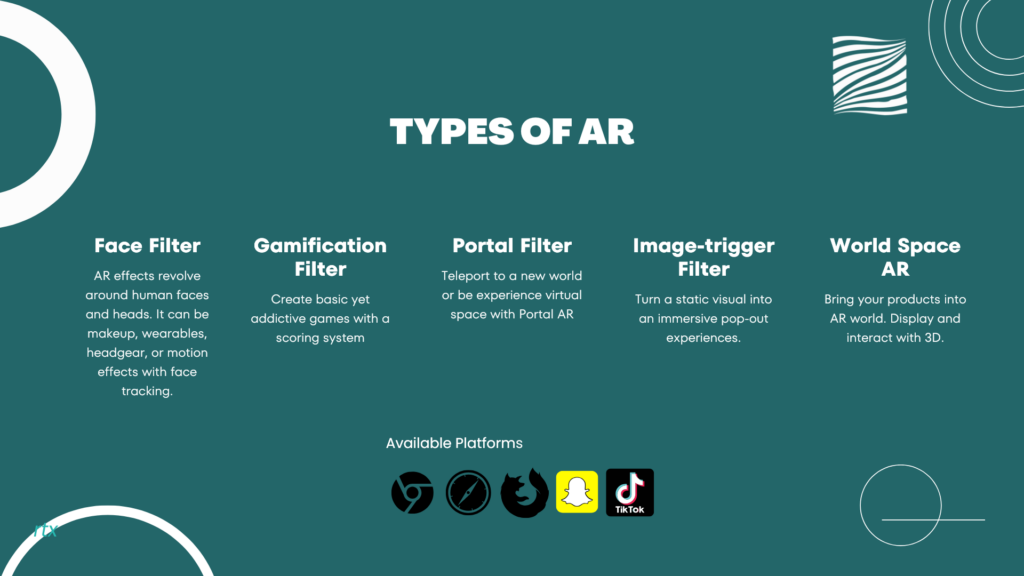
Social AR vs Web AR: What’s the Difference?
| Feature | Social AR (Instagram, FB, TikTok) | Web AR (browser-based) |
|---|---|---|
| Access | Through social apps | Any device browser |
| Virality | High (due to social shareability) | Moderate |
| Customization | Limited | Highly customizable |
| Lead Capture | Not possible | Possible via forms |
| App Download Needed | No | No |
Social AR is ideal for viral reach and UGC. Web AR shines for data capture and direct sales.
3. Design the Experience
This includes UX/UI, storyboarding, 3D design, and tech development.
Designing an AR Experience That Converts
Design matters—AR success hinges on the user journey. Here’s what we handle:
- UX/UI Flow: Intuitive and quick-to-navigate
- 2D/3D Assets: Branded, playful, or elegant
- Animations: Make it move to make it memorable
- Backend & Analytics: Capture everything from opens to shares
4. Promote Strategically
Use teasers, influencer outreach, and store integration to drive participation.
Pre-Launch Strategy for AR Marketing
- Teaser trailers or countdowns
- Influencer seeding before public release
- Press outreach and blog coverage
- Landing pages with explainer videos
Influencer Marketing in AR Campaigns
Influencers love AR filters. They feel exclusive and interactive. Give them a branded lens and let them spark the trend.
Promoting AR Campaigns Across Channels
- Organic Social: Showcase how to use the AR feature
- Paid Ads: Drive traffic directly to AR experience
- In-Store: Signage, staff training, QR code standees
- Email & SMS: Perfect for buyer-only redemption campaigns
5. Measure and Optimize
Track opens, shares, leads, coupon redemptions, and iterate accordingly.
AR for Lead Generation and CRM
Web AR enables:
- Custom forms
- Phone/email capture
- CRM integration
- Segmentation and retargeting
Sales Enablement with AR Marketing
Tie AR to a specific product or purchase requirement:
- Trigger filters with receipts or packaging
- Offer limited-time coupons for participants
- Announce exclusive drops via AR experience
Post-Campaign Analytics and Reporting
We provide:
- Real-time dashboards
- UGC volume reports
- Filter share & open data
- Redemption and lead insights
Common Mistakes in AR Campaigns & How to Avoid Them
- Overcomplicating the journey
- Not giving clear CTAs
- Forgetting follow-up retargeting
- Underinvesting in promotion
Final Takeaway
AR isn’t the future—it’s the now. It’s not just a cool tech gimmick. It’s a full-blown marketing strategy that boosts awareness, supercharges engagement, and drives conversions.
From gamified UGC to sales-linked packaging, Mekongverse and Rangoon.tech can help you create memorable, immersive campaigns that truly connect.

